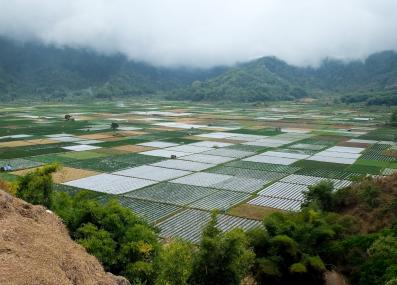Have a question?
What method of waste disposal is best for the climate?
All waste disposal methods release greenhouse gases, and it's hard to make apples-to-apples comparisons. But there's only one solution that doesn't contribute to climate change at all: not making waste in the first place.
December 21, 2020
Every day, the U.S. creates about 4.9 lbs of trash per person.1 In 2018, this amounted to 292 million tons of trash.1 But what sort of impact does all this trash have on greenhouse gas emissions? The situation isn’t good, says Jonathan Krones, Visiting Assistant Professor of Environmental Studies at Boston College. “There is no sustainable scenario in which we consume a lot of materials, particularly single-use materials,” Krones says, “and rely on disposal processes to manage the waste and mitigate its effect on human and environmental health.”
Currently, we have two major ways to deal with non-recyclable waste: we can put it into a landfill or burn it in an incinerator. Burning waste may seem like a better way to permanently get rid of it—once the trash is burned, it appears to be “gone.” However, burning trash simply transforms it from a solid to a gas (and creates ash that must later be landfilled). When the trash contains hazardous materials (like some metals), this gas can be toxic. When it’s a material that’s mostly made up of carbon (like plastic), the gas will contain CO2, which contributes to global warming.
On the other hand, burning waste also releases energy. In a “waste-to-energy plant,” this energy can be used to make electricity, replacing some electricity that normally comes from fossil fuels like coal and natural gas.
Our other option, putting waste into a landfill, also releases greenhouse gases. Modern sanitary landfills are highly engineered facilities, neatly organized into cells, sort of like a honeycomb. Once a cell is filled with trash, it is sealed and capped to minimize contact with the surrounding environment. Inside the cell, the trash is packed down tightly, squeezing out all the oxygen. This means that the organic portion of the trash (think food waste, or wood) decomposes anaerobically (without oxygen), producing methane, a potent greenhouse gas, as a byproduct. In 2018, landfills accounted for 17% of total methane emissions in the U.S., the equivalent of 111 million metric tons of CO2—and they can continue to release methane for up to 50 years after they are filled.2,3 Landfill gas collection systems allow this gas to be used as a source of energy.
But which one is better? Unfortunately, there isn’t a definitive answer, and it varies facility by facility. Landfill gas collection systems are far from universal and only collect 60-90% of the landfill gas generated.4 Waste-to-energy plants sometimes have to add natural gas or oil to help the not-so-flammable trash burn, which increases their CO2 emissions. “The problem is that most existing landfills don’t have landfill gas collection systems and electricity from waste-to-energy plants isn’t that much less carbon intensive than the grid,” says Krones. “These technologies are improving the emissions profile of waste disposal, but not by enough. In order to deal with climate change, the world needs to eliminate greenhouse gas emissions completely.”
What about recycling—is that an emissions-free way to get rid of waste? Unfortunately, no. “While recycling reduces emissions associated with disposal and the creation of a new product, there are also added emissions from the recycling process itself,” says Krones. Let’s illustrate this with a can of beans. When you’re finished with the beans, you throw the aluminum can into a recycling bin. Once the recycling truck (which emits CO2) drops it off at the recycling facility, the can has to be separated from other recyclable waste, cleaned, and melted, all of which requires energy (which most often comes from burning fossil fuels). And depending on the quality of the recycled aluminum, some new aluminum might need to be added to create a new can.
Fortunately, even with this imperfect process, recycling metals clearly lowers emissions of CO2. The same is true for some plastics and paper. However, recycling other materials, like glass, doesn’t necessarily lower CO2 emissions. As Krones says, “recycling is incredibly important and something worth improving, but it is also important to note that recycling alone cannot fix the climate problem.”
So what are we supposed to do with our trash? “The answer is not producing waste in the first place,” says Krones. Basically, we need to address production and consumption. One place to start is for manufacturers to make durable or highly recyclable products that won’t quickly become waste, or source their materials in ways that pull waste out of the system. For example, Adidas has a partnership with the non-profit Parley for the Oceans to intercept plastic bottles headed for the ocean and repurpose them into shoes.5
Government policies can also influence the waste system. For example, Europe’s “Single Use Plastic Directive” bans plastic food containers and includes “Extended Producer Responsibility” schemes, which require companies to cover the cost of collecting, transporting, and recycling plastics. (A bill in the current U.S. Congress draws on many of these same ideas.) Policymakers can also help consumers buy fewer disposable goods, through education or taxes and regulations.
“To best reduce emissions from trash disposal, laws and regulations around waste need to be laws and regulations around production and consumption,” says Krones. “If we want to continue living fairly normal, decent lives as we perceive them today, we need to develop a framework for balancing the environmental bills.” In other words, we must first reduce and then reuse and recycle our waste before we can even consider its disposal.
Thank you to Mike Agronin of Baltimore, Maryland, for the question. You can submit your own question to Ask MIT Climate here.
Submit your own question to Ask MIT Climate
Get the latest from Ask MIT Climate monthly in your inbox
1 U.S. Environmental Protection Agency, National Overview: Facts and Figures on Materials, Wastes and Recycling.
2 U.S. Environmental Protection Agency, 1990-2018 National-Level U.S. Greenhouse Gas Agency Fast Facts.
3 U.S. Environmental Protection Agency, Basic Information About Landfill Gas.
4 U.S. Environmental Protection Agency, Benefits of Landfill Gas Energy Projects.
5 Business Insider, "14 companies that are capitalizing on the unpopularity of plastics," April 16, 2019.








